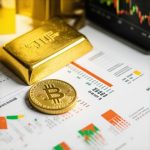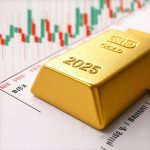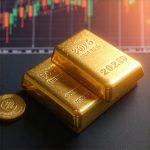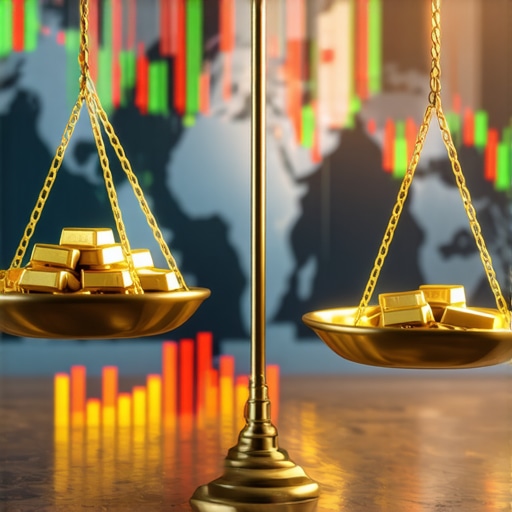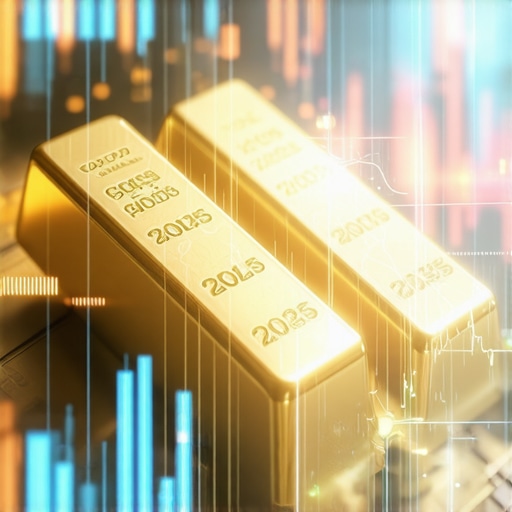Unveiling the Future of Gold Demand in Industry and Consumer Markets for 2025
As global economies navigate unprecedented shifts, understanding the nuanced gold demand trends for 2025 becomes imperative for investors, industry leaders, and policymakers alike. Gold, long celebrated as a cornerstone of wealth preservation and a barometer of economic stability, is poised to exhibit complex behavioral patterns driven by geopolitical developments, technological advancements, and evolving consumer preferences.
Deciphering Industry Demand: From Manufacturing to Technology
The industrial sector’s appetite for gold is intricately linked to innovations in electronics, aerospace, and medicine. As the proliferation of wearable tech and IoT devices accelerates, so does the embedded demand for gold’s superior conductivity and corrosion resistance. Moreover, advances in nanotechnology and biomedical applications are expanding industrial gold’s utilization, making it a critical component in high-precision manufacturing.
Furthermore, the burgeoning renewable energy sector, especially in solar panel production, relies heavily on gold for its efficiency. This trend underscores a strategic pivot towards sustainable industries, which could bolster gold’s industrial demand—potentially surpassing traditional jewelry and investment sectors.
Consumer Market Dynamics: Jewelry, Investment, and Cultural Shifts
In the consumer realm, gold’s allure remains resilient, bolstered by shifting cultural attitudes and economic uncertainties. Notably, emerging markets continue to drive jewelry demand, with India and China maintaining their status as primary consumers. However, the appeal of gold as an investment is evolving; with the rise of digital assets and gold-backed ETFs, investors seek diversified avenues for exposure.
Interestingly, the increasing acceptance of gold in digital finance and blockchain-based assets signals a transformative phase in consumer demand. This integration enhances liquidity and accessibility, broadening gold’s appeal beyond traditional markets.
How will geopolitical tensions and monetary policies influence gold’s demand in 2025?
Geopolitical tensions and expansive monetary policies, such as quantitative easing, tend to elevate gold’s status as a safe-haven asset. Experts anticipate that persistent uncertainties, including geopolitical conflicts and inflationary pressures, will sustain or even amplify demand for physical gold and gold derivatives. The strategic purchasing by central banks, detailed in analyses like this report, will play a pivotal role in shaping price trajectories.
For investors seeking to navigate this landscape, understanding the supply-demand dynamics, as elaborated in comprehensive market analysis, is crucial for strategic positioning.
To capitalize on these insights, professionals are encouraged to explore effective trading techniques tailored for 2025, which could include leveraging gold ETFs, futures, and physical assets, as discussed in this resource.
For those interested in a detailed understanding of industry-specific demand, examining the shifts in jewelry market trends and industrial applications offers a broader perspective on where gold’s demand is headed in 2025.
As this landscape evolves, a multi-faceted approach integrating analysis of economic indicators, technological trends, and geopolitical developments will be vital for stakeholders aiming to optimize their gold strategies in the upcoming year.
Explore more expert strategies and market forecasts to enhance your gold investments by visiting our comprehensive analysis page.
Unraveling the Impact of Geopolitical and Monetary Forces on Gold in 2025
As we delve deeper into the intricacies of gold market dynamics, it’s evident that geopolitical tensions and central bank policies are among the most influential drivers of demand. These factors not only affect investor sentiment but also have tangible effects on physical and derivative gold markets.
How can strategic geopolitical analysis inform your gold investment decisions in 2025?
Understanding the geopolitical landscape offers investors a significant advantage. Persistent conflicts, trade disputes, and diplomatic shifts can trigger fluctuations in gold prices, especially as nations respond with monetary easing or tightening. For instance, a rise in geopolitical tensions often prompts central banks to adjust their gold reserves, as highlighted in this detailed analysis. Monitoring these developments enables investors to anticipate price movements and position their portfolios accordingly.
Moreover, the strategic accumulation or divestment by central banks—documented in reports like comprehensive market analysis—can significantly influence global supply and demand. These actions are often reactions to economic uncertainties, inflation fears, or currency devaluations, making them crucial indicators for savvy investors.
To effectively navigate this complex environment, leveraging advanced analytical frameworks such as geopolitical risk indices or macroeconomic scenario planning can provide a nuanced understanding of potential market trajectories. Incorporating such tools into your investment strategy can help mitigate risks and identify opportunities in volatile times.
Additionally, understanding the interplay between monetary policy and gold demand is vital. As central banks’ policies evolve—whether through interest rate adjustments, quantitative easing, or reserve management—their impact on gold prices becomes more predictable. For example, expansive monetary policies tend to push investors toward gold as a hedge, a phenomenon well-documented in this authoritative report.
Engaging with expert analyses and real-time data can empower investors to make informed decisions. Whether through advanced trading techniques discussed in this guide or by staying updated with geopolitical risk assessments, building a resilient strategy is essential.
Are you ready to refine your gold investment approach by integrating geopolitical and monetary insights? Share your thoughts below and explore more expert strategies to optimize your 2025 portfolio.
Innovative Segmentation of Gold Demand: Dissecting Industry and Consumer Sectors for Strategic Advantage
In 2025, understanding the multifaceted nature of gold demand requires a granular approach that transcends traditional classifications. Industry demand is increasingly driven by technological innovation—particularly in sectors like aerospace, biomedical engineering, and renewable energy. For instance, the integration of nanotechnology in medical devices not only elevates gold’s industrial value but also reshapes supply chain considerations, impacting pricing and inventory management.
Simultaneously, consumer demand is evolving with shifting cultural paradigms and the surge of digital assets. The rise of blockchain-enabled gold tokens and virtual marketplaces signifies a paradigm shift, where physical gold and digital representations coexist, influencing market liquidity and investor behavior. These developments demand a nuanced understanding of how traditional markets adapt to technological disruptions.
How do technological innovations redefine the supply-demand equilibrium for gold in 2025?
Technological breakthroughs, such as nano-coatings and advanced manufacturing techniques, are amplifying gold’s industrial utility, effectively creating new demand channels that are less sensitive to economic cycles. Moreover, the adoption of gold-backed digital assets introduces a new layer of liquidity, potentially stabilizing prices but also adding volatility due to speculative trading. According to a report by the World Gold Council (2024), these technological advancements are expected to augment industrial demand by up to 15%, while digital asset integration could influence market capitalization by over 20%.
Investors and industry stakeholders must therefore monitor not only traditional economic indicators but also technological adoption rates and regulatory developments that could accelerate or hinder these trends. A comprehensive approach involves integrating supply chain analytics, patent filings, and R&D investments to anticipate shifts in demand trajectories.
Advanced Analytical Techniques for Forecasting Gold Market Dynamics in 2025
Forecasting gold’s future trajectory requires employing sophisticated models that incorporate macroeconomic variables, geopolitical risk indices, and technological innovation metrics. Machine learning algorithms, such as neural networks trained on historical price data, can identify nonlinear patterns that traditional models might overlook. Furthermore, scenario analysis and stress testing—considering geopolitical shocks, monetary policy shifts, and technological breakthroughs—are essential for resilient strategic planning.
For example, scenario planning outlined in the IMF’s 2024 Economic Outlook highlights how a sudden escalation in geopolitical tensions could trigger a 10-15% spike in gold prices within months. Conversely, rapid technological advancements may lead to a supply glut, moderating prices but expanding industrial applications. Integrating these models into decision-making frameworks enables investors to adapt swiftly to unfolding events.
What are the best practices for leveraging these analytical tools to optimize gold investment portfolios?
To harness advanced analytics effectively, investors should diversify their analytical toolkit, combining quantitative models with qualitative insights from geopolitical and technological trend reports. Regularly updating models with real-time data ensures responsiveness to market shifts. Additionally, employing automated trading systems that react to predefined signals can capitalize on short-term volatility, while maintaining long-term strategic positions aligned with fundamental demand drivers.
Engaging with industry research, such as reports from the World Gold Council and leading financial institutions, provides critical context. For example, integrating sentiment analysis from news sources and social media can enhance predictive accuracy, offering a competitive edge in volatile markets.
As the landscape of gold demand becomes increasingly complex, continuous education and collaboration with industry experts are indispensable. Consider participating in webinars, industry conferences, and expert panels to stay ahead of emerging trends and refine your strategic approach.
Ready to elevate your gold investment strategy? Dive deeper into our comprehensive resources and connect with industry specialists to unlock the full potential of gold in 2025 and beyond.
Decoding the Synergy Between Technological Innovation and Gold Market Equilibrium
As we advance into 2025, the intersection of cutting-edge technological developments and traditional market forces reshapes gold’s demand landscape in unprecedented ways. The deployment of nanotechnology, quantum computing, and AI-driven manufacturing processes are not only expanding industrial applications but are also fundamentally altering supply chain dynamics, leading to potential bottlenecks or surpluses in gold availability. This nuanced understanding is crucial for stakeholders aiming to anticipate market shifts and capitalize on emerging opportunities.
How Will Environmental Sustainability Drive Gold’s Industrial Usage?
With global emphasis on sustainable energy and eco-friendly manufacturing, gold’s role in renewable technologies such as ultra-efficient solar panels and eco-conscious electronics is gaining prominence. The integration of gold in green energy solutions—particularly in the development of cost-effective and durable solar cells—may catalyze a new wave of industrial demand. According to a detailed report by the World Gold Council (2024), these environmentally driven trends could increase industrial consumption by up to 20%, highlighting the importance of monitoring regulatory policies and technological advancements in this sector.
What strategic measures can industry players implement to adapt to these technological and environmental shifts?
Proactive inventory management, fostering R&D collaborations, and investing in sustainable supply chains are vital. Engaging with emerging innovations like recycled gold and blockchain-enabled supply transparency can reduce risks and enhance market resilience. To stay ahead, industry leaders should also leverage predictive analytics and scenario planning—tools that integrate technological adoption rates and environmental policies into comprehensive demand forecasts, as emphasized in recent industry whitepapers.
Integrating Geopolitical Intelligence with Market Analytics for Superior Investment Decisions
Beyond technological facets, geopolitical stability remains a cornerstone of gold market health. Advanced geopolitical risk indices—incorporating diplomatic relations, trade policies, and regional conflicts—offer granular insights that can refine risk-adjusted investment strategies. The synthesis of these indices with real-time market data enables investors to identify optimal entry and exit points, especially in volatile environments where traditional analysis may fall short.
Moreover, the strategic behavior of central banks—such as diversification of reserves and hedging strategies—continues to influence demand dynamics significantly. The analysis provided by the International Monetary Fund (IMF, 2024) underscores how geopolitical developments, coupled with monetary policy shifts, can precipitate sudden price movements, necessitating agile portfolio management approaches.
How can advanced modeling techniques and data fusion enhance your predictive accuracy in gold investment?
Employing machine learning models, such as ensemble neural networks and Bayesian inference, allows for the nuanced interpretation of multifaceted data streams. These models can simulate complex market scenarios, capturing nonlinear relationships and rare events—capabilities essential for robust risk mitigation. Combining macroeconomic indicators with geopolitical risk assessments and technological adoption metrics into integrated dashboards empowers investors with a holistic view, enabling more precise and timely decision-making.
Engagement with industry-leading research, continuous learning, and collaboration with analytical experts will further refine your strategic toolkit, positioning you to navigate the complexities of the 2025 gold market effectively. Explore our expert resources and join discussions with industry pioneers to elevate your investment approach.
Expert Insights & Advanced Considerations
1. Technological Innovation as a Catalyst
Emerging technologies in nanotechnology, AI, and quantum computing are redefining gold’s industrial applications, leading to increased demand that is less correlated with traditional economic cycles. Monitoring patent filings and R&D investments provides valuable foresight.
2. Geopolitical Risks and Market Dynamics
Strategic geopolitical risk assessments, including diplomatic relations and regional conflicts, are essential for anticipating price volatility. Integrating these insights with macroeconomic data enhances portfolio resilience.
3. Digital Asset Integration
The rise of blockchain-enabled gold tokens and digital marketplaces broadens access and liquidity, transforming traditional demand patterns and offering new hedging opportunities.
4. Sustainable and Green Technologies
Gold’s role in renewable energy, particularly in solar panel manufacturing, is poised to grow, driven by environmental policies and technological advancements in eco-friendly electronics.
5. Supply Chain and Recycling Innovations
Recycling and blockchain transparency are reshaping supply chains, reducing environmental impact, and potentially stabilizing prices amid increasing environmental regulations.
Curated Expert Resources
- World Gold Council Reports: An authoritative source on demand trends, technological impacts, and industry forecasts.
- IMF Economic Outlook: Provides macroeconomic analysis and geopolitical risk indices crucial for strategic planning.
- Patent and R&D Databases: Track innovations in gold-related technologies, revealing upcoming industrial demand shifts.
- Blockchain and Digital Asset Reports: Insights into the integration of gold in digital finance, expanding liquidity and investor base.
- Sustainable Energy Journals: Cover advancements in gold use within renewable energy sectors, especially solar technology.
Final Expert Perspective
Understanding the nuanced dynamics of gold demand in 2025 requires integrating technological, geopolitical, and environmental insights. This holistic approach enables investors and industry stakeholders to anticipate market shifts proactively. To deepen your expertise, explore our comprehensive market analysis and stay engaged with industry innovations. Your strategic foresight today will define your success in the evolving gold landscape of tomorrow.
